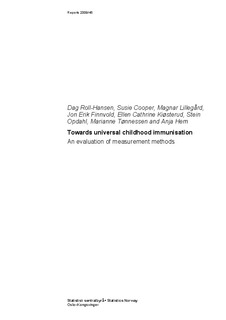| dc.description.abstract | Childhood immunisation programming is an essential part of every country’s
health programme to reduce vaccine preventable diseases. The Global Alliance on
Vaccines and Immunisation (GAVI) was established to help fund and implement
universal childhood immunisation. Funding provided by GAVI through its
immunisation service support (ISS) is performance-based, with funds disbursed in
proportion to the targeted or reported number of additional children immunised.
In 2008, Lim, Stein, Charrow and Murray published the article “Tracking progress
towards universal childhood immunisation and the impact of global initiatives: a
systematic analysis of three-dose diphtheria, tetanus, and pertussis immunisation
coverage“ in the Lancet. In the article, they raise a concern that fewer children have
been immunised than officially reported and that this has significant health and
financial consequences.
The main findings from the assessment of this study are as follows:
a) The study by Lim et al. (2008) estimates DTP3 coverage using officially
reported coverage and survey data for 193 countries. Time-series analysis
investigates the association between the presence of GAVI ISS and the
difference between countries officially reported and survey based
immunisation coverage.
b) In general, vaccination coverage based on administrative data was significantly
higher than survey based vaccination coverage estimates. Furthermore, the
study showed that 7.4 million additional children were immunised under ISS
based on survey data compared to 13.9 million addition children reportedly
immunised. This amounts to a difference of around US$140 million in support
money.
c) We believe the amount of data analysed in the study is extensive and indicates
that results are of a robust nature. The methodology (including the use of selfreported
vaccinations) is validated with additional background information and
studies supporting the authors’ decisions.
d) The study shows that their new imputation method, bidirectional distancedependent
regression (BDDR), performs similarly to the more commonly used
multiple imputation method, validating its use. However, we believe in the
absence of survey data, quick changes in immunisation coverage may not
always be detected by the model, especially in recent estimates where there are
no following surveys.
e) The study by Lim et al. (2008) has lumped together investment and reward
payments for countries receiving GAVI ISS, which we believe may be
problematic due to the differing nature of payment calculations.
f) Additionally, we believe vulnerable groups may be less likely to participate in
surveys and similarly be difficult to reach for preventive health care
programmes. This implies survey data may overestimate immunisation
coverage.
In order to learn more about potential disparities between vaccination coverage
reported in surveys and administrative data we have carried out case studies in four
countries. Despite the existence of clearly defined administrative routines, the
overall impression is that administrative data are subject to considerable
uncertainty.
a) The countries selected for field studies all experienced high staff turnover and
vacancies. There was a lack of relevant personnel and inadequate resources
both in the organisations set up to give vaccines and to record the
administrative data.
b) A lack of understanding for the importance of accurate reporting of
vaccinations was often observed.
c) Measures of the target population (the number of children to be vaccinated) are
often uncertain. | no_NO |
